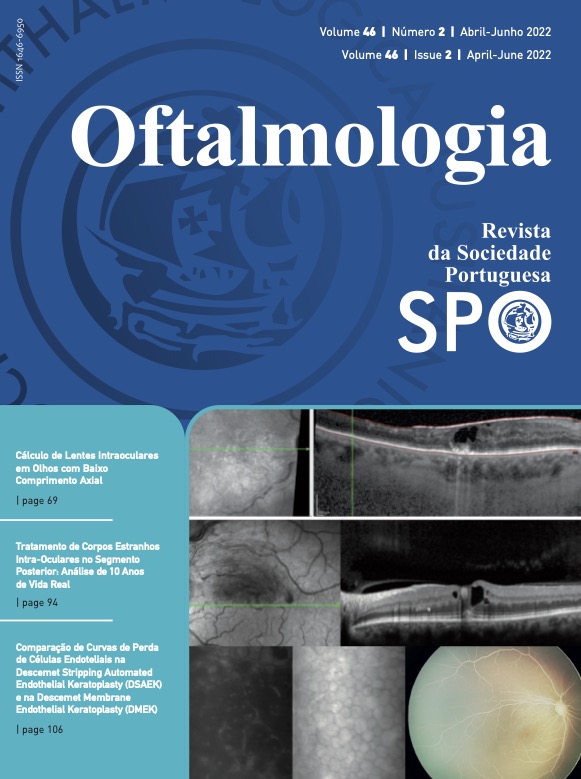Bacterial Keratitis: A Retrospective Review of 10 Years of Cultures
DOI:
https://doi.org/10.48560/rspo.25274Keywords:
Eye Infections, Bacterial/microbiology, Drug Resistance, Bacterial, Keratitis/ diagnosis, Keratitis/drug therapy, Pseudomonas Infections, Pseudomonas aeruginosaAbstract
INTRODUCTION: The purpose of this study is to evaluate demographic features, risk factors, bacterial isolates, antibiotic resistance patterns and therapeutic approach of bacterial keratitis over a period of 10 years in a tertiary referral hospital in Lisbon.
M E T HO D S : Retrospective review of all bacterial keratitis diagnosed between 2009 and 2019.
RESULTS: A total of 350 patients were diagnosed with bacterial keratitis between 2009 and 2019. Mean age was 54.77 years and 55% of patients were female. Based on first clinical observation, 72.3% of patients were classified as having serious keratitis and 60.86% were managed as in-patients. Contact lenses were the major risk factor identified (30.3%), followed by previous keratoplasty (11.1%) and ocular trauma (10.9%). Cultures were positive for bacteria in 56.86% of patients, with gram-negative bacteria comprising more than half of the isolates (52.26%). Pseudomonas aeruginosa was the most common single isolate (16.3%). Monotherapy with fluoroquinolones was given to 5.7% of patients and 75.4% were treated with fortified drops of ceftazidime and vancomycin. As for outcomes, 41 patients (11.7%) were submitted to a corneal transplant and five patients were eviscerated.
CONCLUSION: Bacterial keratitis is a potentially blinding condition that leads to a great number of emergency department visits and inpatient care. Over the last 10 years, Pseudomonas aeruginosa has been the single most common bacterial isolate and contact lens wear the most frequent risk factor for bacterial keratitis in our center. Identifying bacterial isolates and their resistance pattern is of utmost importance for optimal management of patients.
Downloads
References
Bacterial Keratitis PPP - 2018 [Internet]. American Academy of Ophthalmology. 2018 [cited 2020 Apr 6]. Available from: https://www.aao.org/preferred-practice-pattern/bacterial- keratitis-ppp-2018
Austin A, Lietman T, Rose-Nussbaumer J. Update on the Management of Infectious Keratitis. Ophthalmology. 2017; 124:1678–89. doi: 10.1016/j.ophtha.2017.05.012.
Shah A, Sachdev A, Coggon D, Hossain P. Geographic variations in microbial keratitis: an analysis of the peer-reviewed literature. Br J Ophthalmol. 2011; 95:762–7. doi: 10.1136/ bjo.2009.169607.
Green M, Apel A, Stapleton F. Risk factors and causative organisms in microbial keratitis. Cornea. 2008; 27:22–7. doi: 10.1097/ICO.0b013e318156caf2.
Ung L, Bispo PJM, Shanbhag SS, Gilmore MS, Chodosh J. The persistent dilemma of microbial keratitis: Global burden, diagnosis, and antimicrobial resistance. Surv Ophthalmol. 2019;64:255–71. doi: 10.1016/j.survophthal.2018.12.003.
Austin A, Schallhorn J, Geske M, Mannis M, Lietman T, Rose-Nussbaumer J. Empirical treatment of bacterial keratitis: an international survey of corneal specialists. BMJ Open Oph- thalmol. 2017; 2:e000047. doi: 10.1136/bmjophth-2016-000047.
Truong DT, Bui MT, Memon P, Cavanagh HD. Microbial keratitis at an urban public hospital: a 10-year update. J Clin Exp Ophthalmol. 2015; 6:498. doi: 10.4172/2155-9570.1000498.
Oliveira-Ferreira C, Leuzinger-Dias M, Tavares-Ferreira J, Torrão L, Falcão-Reis F. Microbiological Profile of Infectious Keratitis in a Portuguese Tertiary Centre. J Ophthalmol. 2019; 2019:6328058. doi: 10.1155/2019/6328058.
Tan SZ, Walkden A, Au L, Fullwood C, Hamilton A, Qamruddin A, et al. Twelve-year analysis of microbial keratitis trends at a UK tertiary hospital. Eye. 2017; 31:1229–36. doi: 10.1038/ eye.2017.55.
Vital MC, Belloso M, Prager TC, Lanier JD. Classifying the severity of corneal ulcers by using the “1, 2, 3” rule. Cornea. 2007; 26:16–20. doi: 10.1097/ICO.0b013e31802b2e47.
Almizel A, Alsuhaibani FA, Alkaff AM, Alsaleh AS, AL-Mansouri SM. Bacterial profile and antibiotic susceptibility pattern of bacterial keratitis at a Tertiary Hospital in Riyadh. Clin Ophthalmol.. 2019; 13:2547–52. doi: 10.2147/OPTH.S223606.
Shalchi Z, Gurbaxani A, Baker M, Nash J. Antibiotic resistance in microbial keratitis: ten-year experience of corneal scrapes in the United Kingdom. Ophthalmology. 2011; 118:2161–5. doi: 10.1016/j.ophtha.2011.04.021.
Keay L, Edwards K, Naduvilath T, Taylor HR, Snibson GR, Forde K, et al. Microbial keratitis predisposing factors and morbidity. Ophthalmology. 2006; 113:109–16. doi: 10.1016/j. ophtha.2005.08.013.
Tena D, Rodríguez N, Toribio L, González-Praetorius A. Infectious keratitis: microbiological review of 297 cases. Jpn J Infect Dis. 2019; 72:121–3. doi: 10.7883/yoken.JJID.2018.269.
Okonkwo AC, Siah WF, Hogg HD, Anwar H, Figueiredo FC. Microbial keratitis in corneal grafts: predisposing factors and outcomes. Eye. 2018; 32:775–81. doi: 10.1038/eye.2017.310.
Orlans HO, Hornby SJ, Bowler IC. In vitro antibiotic susceptibility patterns of bacterial keratitis isolates in Oxford, UK: a 10-year review. Eye.. 2011; 25:489–93. doi: 10.1038/ eye.2010.231.
Tam ALC, Côté E, Saldanha M, Lichtinger A, Slomovic AR. Bacterial Keratitis in Toronto: A 16-Year Review of the Microorganisms Isolated and the Resistance Patterns Observed. Cornea. 2017; 36:1528–34. doi: 10.1097/ICO.0000000000001390.
Liu HY, Chu HS, Wang IJ, Chen WL, Hu FR. Microbial Keratitis in Taiwan: A 20-Year Update. Am J Ophthalmol. 2019; 205:74–81. doi: 10.1016/j.ajo.2019.03.023.
Bograd A, Seiler T, Droz S, Zimmerli S, Früh B, Tappeiner C. Bacterial and Fungal Keratitis: A Retrospective Analysis at a University Hospital in Switzerland. Klin Monatsbl Augenheilkd. 2019; 236:358–65. doi: 10.1055/a-0774-7756.
Manikandan P, Bhaskar M, Revathy R, John RK, Narendran K, Narendran V. Speciation of coagulase negative staphylococcus causing bacterial keratitis. Indian J Ophthalmol. 2005; 53:59–60. doi: 10.4103/0301-4738.15288.
Das S, Samantaray R, Mallick A, Sahu SK, Sharma S. Types of organisms and in-vitro susceptibility of bacterial isolates from patients with microbial keratitis: A trend analysis of 8 years. Indian J Ophthalmol. 2019; 67:49–53. doi: 10.4103/ijo.IJO_500_18.
Green MD, Apel AJ, Naduvilath T, Stapleton FJ. Clinical outcomes of keratitis. Clin Experiment Ophthalmol. 2007; 35:421– 6. doi: 10.1111/j.1442-9071.2007.01511.x.
Miedziak AI, Miller MR, Rapuano CJ, Laibson PR, Cohen EJ. Risk factors in microbial keratitis leading to penetrating kera- toplasty. Ophthalmology. 1999; 106:1166–70; discussion 1171. doi: 10.1016/S0161-6420(99)90250-6.
Downloads
Published
How to Cite
Issue
Section
License
Copyright (c) 2022 Revista Sociedade Portuguesa de Oftalmologia

This work is licensed under a Creative Commons Attribution-NonCommercial 4.0 International License.
Do not forget to download the Authorship responsibility statement/Authorization for Publication and Conflict of Interest.
The article can only be submitted with these two documents.
To obtain the Authorship responsibility statement/Authorization for Publication file, click here.
To obtain the Conflict of Interest file (ICMJE template), click here





